Download PDF
Download page W1 - Applying the Deficit and Constant Loss Method.
W1 - Applying the Deficit and Constant Loss Method
Overview
In this workshop you will apply the HEC-HMS Deficit and Constant loss method to a modeling application. Initial parameter estimates will be estimated using GIS information and the model will be calibrated through trial and error. HEC-HMS version 4.9 was used to created this workshop. You will need to use HEC-HMS version 4.9, or newer, to open the project files.
Download the initial project files here - start_Deficit_Constant_Workshop.zip
Background
The Deficit and Constant loss method is very similar to the Initial and Constant loss method in that a hypothetical single soil layer is used to account for changes in moisture content. However, the deficit and constant method allows for continuous simulation when used in combination with a canopy method that will extract water from the soil in response to potential evapotranspiration computed in the meteorologic model. Between precipitation events, the soil layer will lose moisture as the canopy extracts infiltrated water. Unless a canopy method is selected, no soil water extraction will occur. This method may also be used in combination with a surface method that will hold water on the land surface. The water in surface storage can infiltrate into the soil layer and/or be removed through evapotranspiration. The infiltration rate is determined by the capacity of the soil layer to accept water. When both a canopy and surface method are used in combination with the deficit constant loss method, the system can be conceptualized, as shown in the following figure.
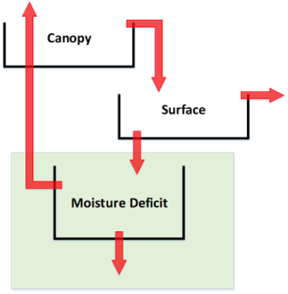
If the moisture deficit is greater than zero, water will infiltrate into the soil layer. Until the moisture deficit has been satisfied, no percolation out of the bottom of the soil layer will occur. After the moisture deficit has been satisfied, the rate of infiltration into the soil layer is defined by the constant rate. The percolation rate out of the bottom of the soil layer is also defined by the constant rate while the soil layer remains saturated. Percolation stops as soon as the soil layer drops below saturation (moisture deficit greater than zero). Moisture deficit increases in response to the canopy extracting soil water to meet the potential evapotranspiration demand. Parameters that are required to utilize this method within HEC-HMS include the Initial Deficit [inches or millimeters], Maximum Deficit [inches or millimeters], and Constant Rate [in/hr or mm/hr]. The Directly Connected Impervious Area [percent] is an optional parameter and can be specified by the user.
Estimate Initial Parameter Values
A Note on Parameter Estimation
The values presented in this workshop are meant as initial estimates. This is the same for all sources of similar data including Engineer Manual 1110-2-1417 Flood-Runoff Analysis and the HEC-HMS Technical Reference Manual. Regardless of the source, these initial estimates must be calibrated and validated.
Maximum Deficit
The maximum deficit is the driest a soil can become under the influence of gravity, evaporation, and transpiration. This parameter is typically estimated as the difference between the saturation storage of the soil and the wilting point storage over an assumed active soil layer depth. However, this parameter should be calibrated using observed data, must be greater than or equal to the initial deficit, and also must be specified as an effective depth (i.e. inches or millimeters).
Saturation Storage
Saturation storage refers to the amount of moisture that can be held within a soil column when all air bubbles have been forced out. This parameter is a function of the effective porosity. To estimate a representative effective porosity throughout the study area, Gridded Soil Survey Geographic (gSSURGO) data for California was obtained from the U.S. Department of Agriculture's Geospatial Data Gateway. Using GIS tools, surficial soil textures were then extracted from the gSSURGO data and are shown in the following figure. Also, the percent of the study area encompassed by each soil texture is shown in the following table.
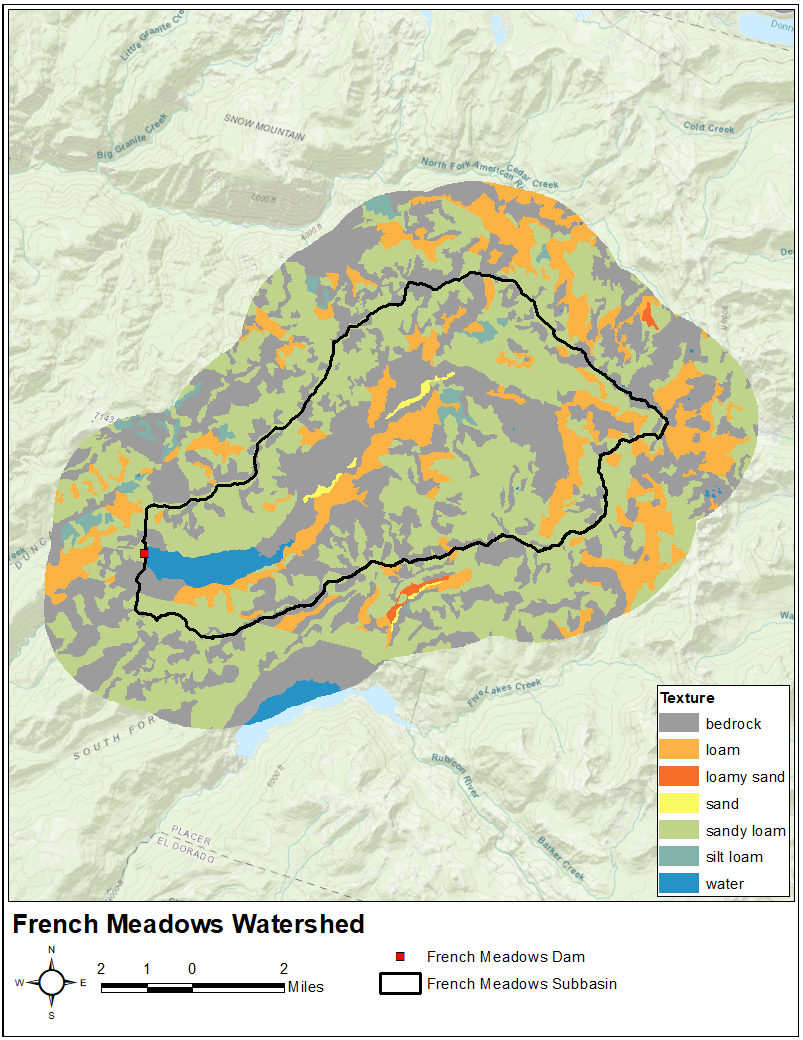
Soil Textures Within the Study Area
Texture | % of Study Area |
|---|---|
| Bedrock | 36.8 |
| Sandy Loam | 44.2 |
| Silt Loam | 1.1 |
| Loam | 13.6 |
| Sand | 0.7 |
| Water | 3.6 |
These surficial soil textures can be used to estimate initial parameter values for nearly all loss methods within HEC-HMS, including the Deficit and Constant loss method. For instance, Rawls, Brakensiek, and Miller (1983) assembled data from thousands of soil samples located throughout the United States and related soil textures to various useful parameters. The effective porosity of various soil textures is shown in the following table.
Soil Textures and Effective Porosity, reproduced from Rawls, Brakensiek, and Miller (1983)
Texture | Effective Porosity |
|---|---|
Sand | 0.42 |
Loamy Sand | 0.40 |
Sandy Loam | 0.41 |
Loam | 0.43 |
Silt Loam | 0.49 |
Sandy Clay Loam | 0.33 |
Clay Loam | 0.31 |
Silty Clay Loam | 0.43 |
Sandy Clay | 0.32 |
Silty Clay | 0.42 |
Clay | 0.39 |
Use the above information to answer the following questions.
Question 1: What are the top three predominant soil textures throughout the study area?
Sandy loam, bedrock, and loam are the three most predominant soil textures (by area) throughout the study area. In fact, these three soil textures cover nearly 95% of the total study area. The remaining soil textures account for a very small percentage of the total area and can be disregarded.
Question 2: What is the effective porosity for the top three predominant soil textures found when answering Question 2? Conservatively assume that bedrock has an effective porosity of 0 in3 / in3.
Sandy loam = 0.41 in3 / in3, bedrock = 0 in3 / in3, and loam = 0.43 in3 / in3.
Estimate an average (i.e. representative) effective porosity for the study area using your answers to the previous two questions. Don't spend too much time being overly precise; instead, quickly estimate the percentage of the study area that is encompassed by each predominant soil texture and multiply by the corresponding effective porosity. Once you've done that for each of the five predominant soil textures, sum the values.
Question 3: What is an average (i.e. representative) effective porosity for the study area?
Sandy loam covers approximately 44% of the total area, bedrock covers approximately 37% of the total area, and loam covers approximately 14% of the total area. Thus, (0.44 * 0.41 in3 / in3) + (0.37 * 0 in3 / in3) + (0.14 * 0.43 in3 / in3) = 0.24 in3 / in3.
Wilting Point Storage
Wilting point storage refers to the amount of water that is so tightly bound to soil particles that it cannot be evaporated or transpired. Technically, this parameter is defined as the water remaining within an initially saturated soil column when subjected to a sustained pressure of -15 bar (i.e. 217.5 pounds per square inch). Like effective porosity, this parameter can also be estimated using surficial soil textures. The wilting point storage of various soil textures is shown in the following table.
Soil Textures and Wilting Point, reproduced from Rawls, Brakensiek, and Miller (1983)
Texture | Wilting Point |
|---|---|
Sand | 0.03 |
Loamy Sand | 0.06 |
Sandy Loam | 0.10 |
Loam | 0.12 |
Silt Loam | 0.13 |
Sandy Clay Loam | 0.15 |
Clay Loam | 0.20 |
Silty Clay Loam | 0.21 |
Sandy Clay | 0.20 |
Silty Clay | 0.25 |
Clay | 0.27 |
Use the above information to answer the following question. Also, (conservatively) assume that bedrock has a wilting point of 0 in3 / in3.
Question 4: What is an average (i.e. representative) wilting point storage for the study area?
Sandy loam covers approximately 44% of the total area, bedrock covers approximately 37% of the total area, and loam covers approximately 14% of the total area. Thus, (0.44 * 0.1 in3 / in3) + (0.37 * 0 in3 / in3) + (0.14 * 0.12 in3 / in3) = 0.06 in3 / in3.
Finally, assume an active soil layer depth of 24 inches and use your answers to the previous questions to answer the following question.
Question 5: What is an average (i.e. representative) maximum deficit for the study area?
This parameter can be estimated by taking the difference between the saturation storage and the wilting point storage over an assumed active soil layer depth. Thus, (0.24 in3 / in3 - 0.06 in3 / in3 ) * 24 inches = 4.3 inches. However, this parameter should be calibrated using observed data.
Initial Deficit
The initial deficit defines the volume of water that is required to fill the soil layer at the start of the simulation while the maximum deficit specifies the total amount of water the soil layer can hold. This parameter is most often estimated using the product of the soil moisture state at the start of the simulation and an assumed active layer depth. However, this parameter must be calibrated using observed data, must be less than or equal to the maximum deficit, and must be specified as an effective depth (i.e. inches or millimeters).
In order to estimate an appropriate initial deficit, the antecedent conditions at the beginning of December 1996 must be investigated. Daily precipitation accumulation, daily snow water equivalent (SWE), and hourly temperature are shown in the following figure.
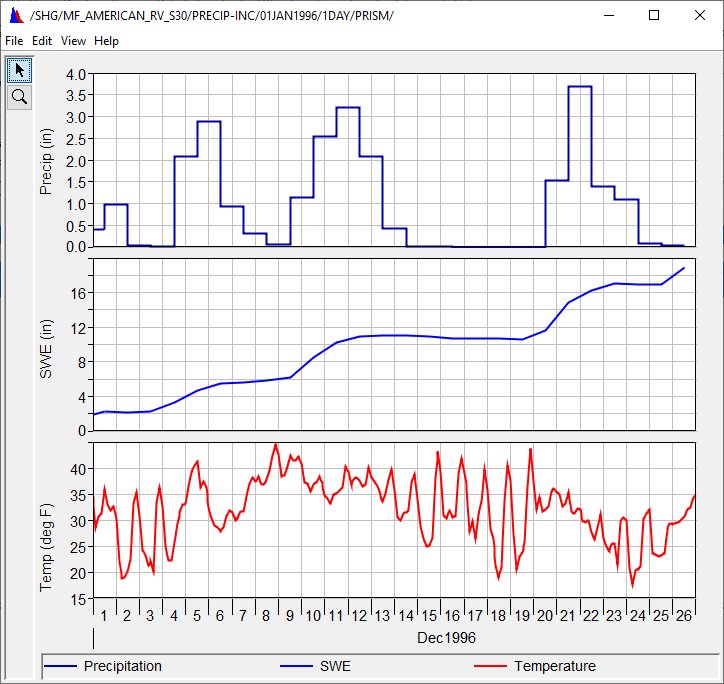
Use the above information and the following information to answer Question 6. Assume that the soil within the study area:
- Was completely saturated by rainfall and melting snow on December 12, 1996 and
Requires approximately 14 days with temperatures continuously above freezing and no rain or melting snow to completely dry under normal conditions.
Question 6: Estimate an initial deficit (in inches) for the study area at the end of December 1996.
A reasonable initial deficit is less than one inch due to temperatures remaining mostly below freezing, as well as some rain and possible melting snow on the 21st before air temperature dropped below freezing. However, this parameter must be calibrated using observed data.
Constant Rate
The constant rate defines the rate at which precipitation will be infiltrated into the soil layer after the initial deficit has been satisfied in addition to the rate at which percolation occurs once the soil layer is saturated. Typically, this parameter is equated with the saturated hydraulic conductivity of the soil which is defined as the rate at which water moves through a unit area of saturated soil in a unit time under a unit hydraulic gradient. This parameter can also be estimated using surficial soil textures. The saturated hydraulic conductivity of various soil textures is shown in the following table.
Soil Textures and Saturated Hydraulic Conductivity, reproduced from Rawls, Brakensiek, and Miller (1983)
Texture | Saturated Hydraulic Conductivity |
|---|---|
Sand | 4.6 |
Loamy Sand | 1.2 |
Sandy Loam | 0.4 |
Loam | 0.1 |
Silt Loam | 0.3 |
Sandy Clay Loam | 0.06 |
Clay Loam | 0.04 |
Silty Clay Loam | 0.04 |
Sandy Clay | 0.02 |
Silty Clay | 0.02 |
Clay | 0.01 |
Use the above information to answer the following question. Also, (conservatively) assume that bedrock has a saturated hydraulic conductivity of 0 in/hr.
Question 7: What is an average (i.e. representative) saturated hydraulic conductivity for the study area?
Sandy loam covers approximately 44% of the total area, bedrock covers approximately 37% of the total area, and loam covers approximately 14% of the total area. Thus, (0.44 * 0.4 in/hr) + (0.37 * 0 in/hr) + (0.14 * 0.1 in/hr) = 0.19 in/hr.
Directly Connected Impervious Area
Directly connected impervious areas are surfaces where runoff is conveyed directly to a waterway or stormwater collection system. These surfaces differ from disconnected impervious areas where runoff encounters permeable areas which may infiltrate some (or all) of the runoff prior to reaching a waterway or stormwater collection system. Within HEC-HMS, no loss calculations are carried out on the percentage of the subbasin that is specified as impervious area; all precipitation that falls on that portion of the subbasin becomes excess precipitation and subject to direct runoff. Within this workshop, a directly connected impervious area percentage of 0 will be assumed.
Modify the Existing HEC-HMS Project
Now that you've estimated initial parameters, begin modifying the existing HEC-HMS project.
- Open the Deficit_Constant_Workshop project and then open the Dec_1996_Jan_1997 Basin Model.
- Select the MF_American_Rv_S30 subbasin element.
- Select the Loss tab to open the Deficit and Constant Component Editor.
- Enter the initial deficit, maximum deficit, constant rate, and directly connected impervious area values that were estimated in the previous section. The Deficit and Constant Component Editor should resemble the following figure.
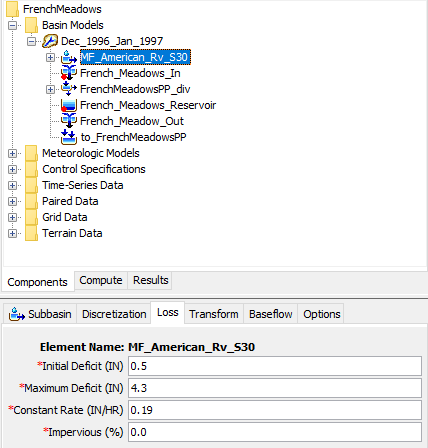
- Select the Dec_1996_Jan_1997 simulation run from the Compute toolbar,
 .
. - Press the Compute All Elements button,
 , to run the simulation.
, to run the simulation. - View the result graph,
 , and summary table,
, and summary table,  , for the MF_American_Rv_S30 subbasin element, as shown in the following figure.
, for the MF_American_Rv_S30 subbasin element, as shown in the following figure.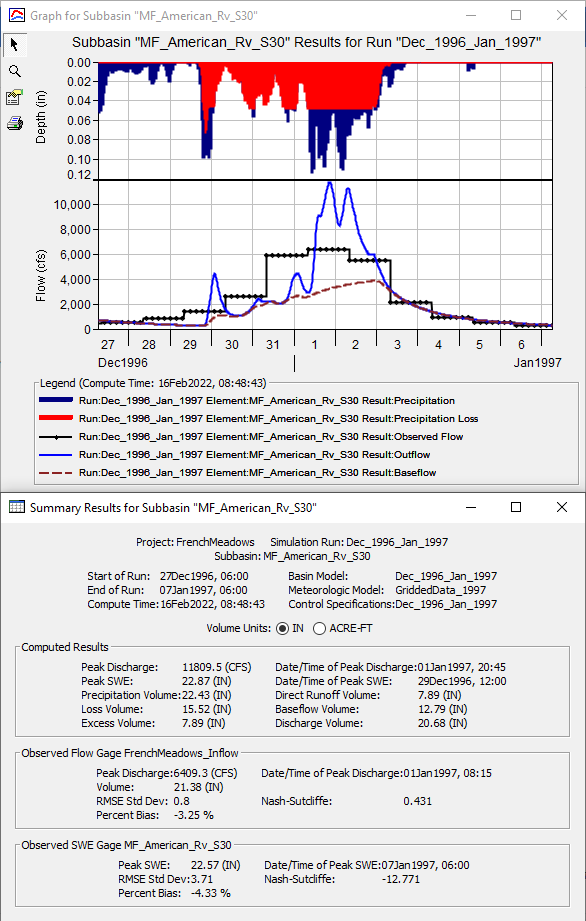
- Click on the Results tab | Dec_1996_Jan_1997 | MF_American_Rv_S30 node and select the Outflow, Cumulative Outflow, Observed Flow, and Cumulative Observed Flow time series, as shown in the following figure.
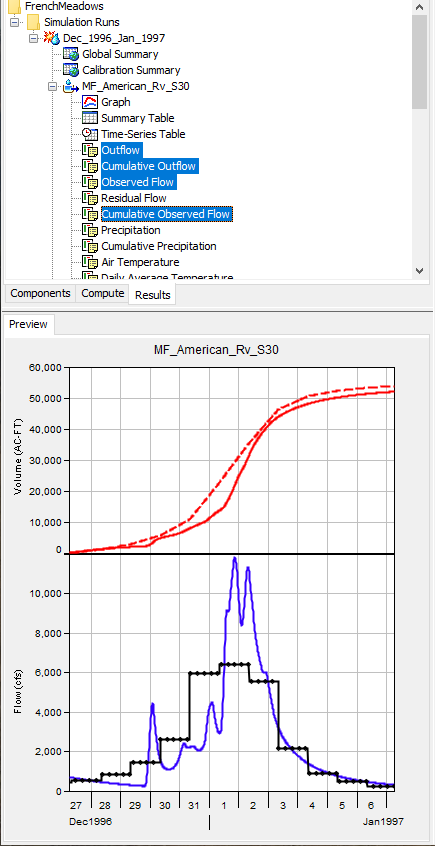
- Open a stand-alone graph for the selected time series by clicking on the View Graph for Selected Elements button.
- View the result graph for the French_Meadows_Reservoir reservoir element, as shown in the following figure.
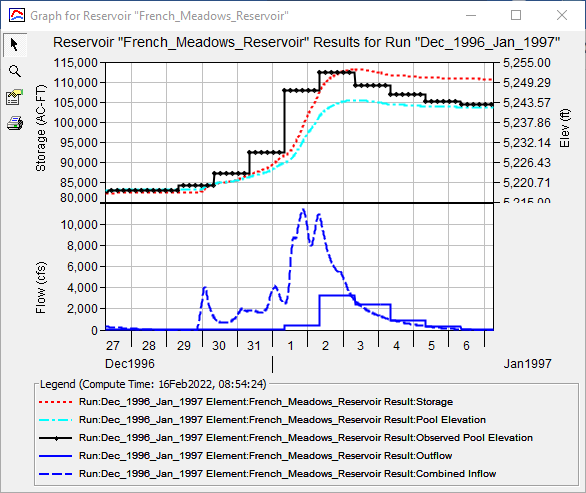
- Leave the plots and summary tables open so you can see results change as you modify the loss method parameters.
- Notice that the computed results are comparable to the observed data. However, there is room for improvement in these results.
- To better match the observed runoff, the Deficit and Constant loss method parameters must be calibrated.
Calibrate the Model
Calibrating a model to afford better agreement between computed and observed runoff oftentimes requires simultaneous changes to more than just one process (e.g. calibrate both loss and baseflow at the same time). However, within this workshop, only the Deficit and Constant loss method parameters will be modified.
- Begin by modifying the loss parameters to approximately match the initiation of runoff.
- The Liquid Water at the Soil Surface (LWASS, which is the amount of precipitation and snowmelt that makes it to the top of the soil column; dark blue) and loss (red) hyetographs for the MF_American_Rv_S30 subbasin element are plotted within the following figure.
Notice that the LWASS volume from the start of the simulation through approximately 30Dec1996 00:00 is used to satisfy the initial deficit (a volume of 0.5 inches). Afterwards, LWASS is infiltrated at a rate of 0.19 in/hr. When using a time step of 15 minutes, the effective rate is 0.0475 inches / 15 minutes (i.e. 0.19 in/hr * 15 / 60).
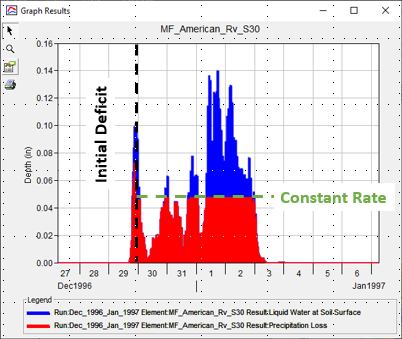
The Deficit and Constant loss method has the ability to extract infiltrated water stored within the soil during periods of no rainfall/snowmelt. However, these capabilities were not used within this workshop. For an example of these capabilities, see this workshop.
- Click on the Results tab | Dec_1996_Jan_1997 | MF_American_Rv_S30 node and select the Outflow, Cumulative Outflow, Observed Flow, and Cumulative Observed Flow time series, as shown in the following figure.
- When looking at the MF_American_Rv_S30 Flow/Cumulative Flow result graph and French_Meadows_Reservoir summary plot, the computed hydrograph and computed pool elevation begins to rise at approximately the same time as the observed data, as shown in Figure 9. However, the computed runoff volume is still less than the observed runoff volume so further modifications are required.
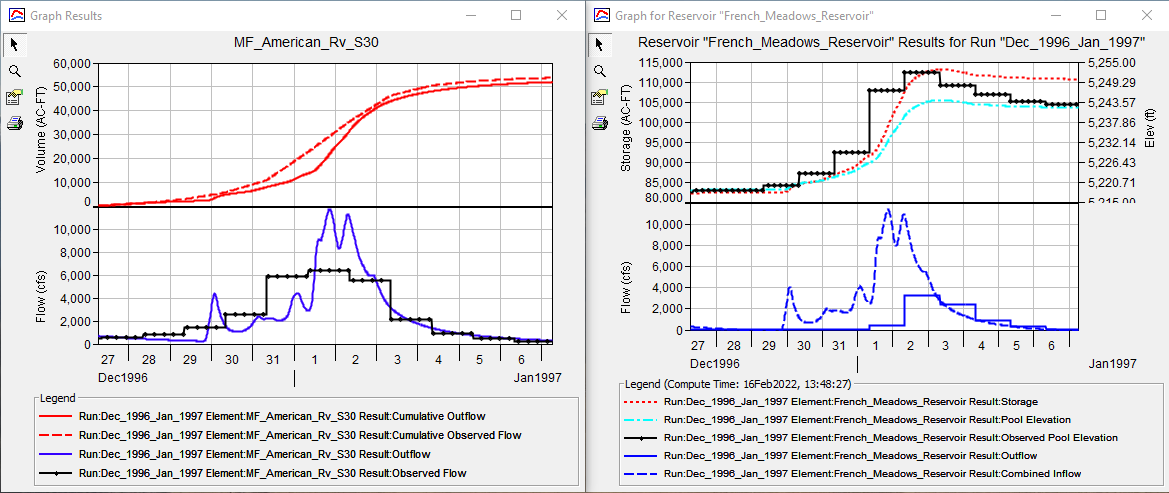
- Continue modifying the loss parameters to approximately match the observed runoff volume.
- Change the constant loss rate to 0.15 in/hr and rerun the simulation.
- Notice that the computed runoff volume is now approximately equal to the observed runoff volume, as shown in the following figure. However, the shape of the computed cumulative runoff hydrograph doesn't match the observed cumulative runoff hydrograph shape from 31Dec1996 - 02Jan1997. These differences are also noticeable when comparing the computed pool elevation and the observed pool elevation during the same time period.
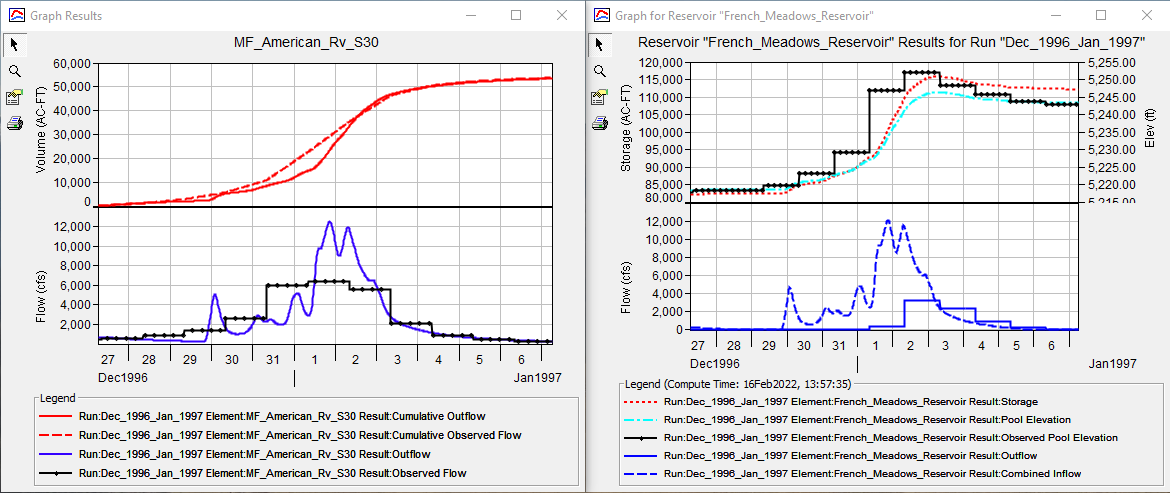
- Continue adjusting the Deficit and Constant loss method parameters in an attempt to simultaneously best match the peak reservoir pool elevation, runoff volume, and hydrograph shape.
- At this point, it should be apparent that simultaneously matching peak reservoir pool elevation, runoff volume, and hydrograph shape can be difficult.
- For instance, matching the rate of rise and runoff volume while only modifying loss rates is nearly impossible to recreate. To better match this response, modifications to snowmelt, unit hydrograph, and/or baseflow parameters may be necessary.